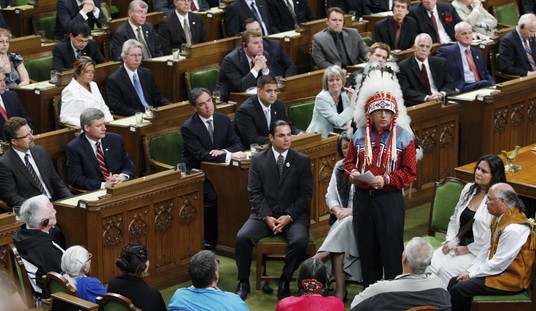The Washington Post/Bloomberg says that gas is predicted to hit $4 a gallon this summer. Nigeria’s production is down from unrest. Venezuela’s is down from mismanagement. “The two countries supply a combined 2 million barrels of oil per day to the U.S.” Oil supplies are tight and things aren’t looking good elsewhere.
the Libyan rebellion shut down the country’s daily exports of 1.5 million barrels of oil. Libya produces about 2 percent of world demand, and analysts say making up for those losses will severely reduce the ability of other oil-producing countries to increase production in the future.
The the reductions come at a time of high demand, and Financial Times says bad luck scenarios could cause temporary price spikes, though analysts hastened to add they were unlikely. One trading executive said “can we reach $175? I don’t think so, but there is a chance of a spike to that level for one or two days if something happens in Saudi Arabia.”
Oil at that level would just about paralyze the world’s economy. Could anything bad happen in Saudi Arabia? The official line is that nothing untoward is happening in the vicinity. As Alex Spillius of the Daily Telegraph reports hearing that nothing is happening in Bahrain either.
I just attended an eye-opening roundtable discussion with several members of Saudi Arabia’s Majlis al-Shura, the advisory council to King Abdullah, at the New America Foundation here in Washington. …
The level of denial about Bahrain, which is the kingdom’s key concern in the region, was startling. One delegate said there was “no major crackdown” in Bahrain, despite the fact that the security forces opened fire in Manama’s Pearl Roundabout, You-Tube footage can be seen of protesters being shot at point blank range, the main opposition newspaper has just been shut down amid the emergency rule imposed a month ago. Not forgetting that Gulf Co-operation Council forces agreed to a cry for help from Bahrain’s royal family, resulting in the Saudi-led intervention of 1,000 troops.
But something definitely is happening if one looks at the Kingdom’s own actions. Saudi Arabia is tying to cast Bahrain in a a key battleground between the Sunni states and Shi’ite Iran, one in which it can no longer count on the US to take their side. Secretary of Defense Robert Gates is visiting the Kingdom “in an attempt to thaw ice-cold relations between Saudi Arabia and the United States,” according to the New York Times.
the countries remain at odds over not only Saudi troops in Bahrain but also Mr. Obama’s support of the protests in Egypt rather than its president, Hosni Mubarak.
After Mr. Mubarak was out of office, the Saudis canceled visits to Riyadh by Mr. Gates and Secretary of State Hillary Rodham Clinton, saying the king was not well. But Pentagon and State Department officials were left wondering if he was more upset than ill. A later call from Mr. Obama to the king asking that Saudi troops not enter Bahrain did not go well. An Arab official later said that King Abdullah’s willingness to listen to the Obama administration had “evaporated” since Mr. Mubarak was ousted.
The Saudis, perhaps disillusioned by Obama’s actions in Egypt, are turning east to Pakistan and China, whether because they’ve truly lost faith in Washington or because they want to play both ends against the middle is unclear. The National Interest’s Bruce Reidel notes the Saudis “are also looking east for help to old allies in Pakistan and China” for help of the more kinetic and authoritarian kind.
Prince Bandar … invoked an understanding that dates back to the 1980s when then-Pakistani dictator Zia ul Huq provided over 10,000 Pakistani troops to protect the country after the Iranian revolution. Bandar also has been in Beijing to promote more trade and to ensure the Chinese communist dictators stand with their Saudi friends. …
This represents a significant foreign policy shift which would be given far more attention by the press if the President were someone else. With a straight face Reidel says “the challenge for Obama and his national security team is to be on both sides of the history-changing tsunami sweeping the Arab world.” He understands how things work in the White House. But how being on both sides of a regional showdown will work in the real world remains to be seen. The jury is still out on whether the efficacy of support from the teleprompter or the potency of announced air strikes which are canceled.
But to be on both sides, President Obama is going to have to even better at being for something before he was against it, and never to be captive to “false choices” which he is never a captive of. As Yogi Berra famously said, “when you come to a fork in the road, take it” and the White House is master of that skill.
As for the KSA, the Hindustan Times says the Kingdom is recruiting mercenaries, that is to say security personnel, from Pakistan, not just to serve in Bahrain but in Saudi Arabia itself.
However, the Pakistan government is believed to have given blessings to the recruitment, which is being conducted through private contractors. More than a hundred retired army men are now on their way to Bahrain to serve in that country’s riot police and defense forces.
Plans are also being finalised to send regular Pakistan army contingents to Saudi Arabia and possibly Bahrain, officials have said privately.
In March, Pakistan received Prince Bandar of the Saudi National Council who proposed that army contingents be sent to Saudi Arabia and Bahrain to prop up the monarchies in the two states.
This visit was followed up by a visit of the Bahrain foreign minister, Sheikh Khalid bin Ahmed bin Mohammed Al Khalifa, who confirmed that the Pakistan Army was willing to send its troops to bolster his government.
The translation service MEMRI reports that China has just signed a major deal to import oil from Saudi Arabia. Aramco is going to supply Yunnan province with oil.
Khalid A. Al-Falih, president and CEO of Aramco, said, “We don’t consider ourselves simply sellers of oil to China, but rather strategic partners whose many relationships in that important country are founded on mutual respect, interdependence and mutual benefit.”
So maybe they’re expecting trouble and are hedging their bets. Yogi Berra has some fans in the Middle East too. If Saudi Arabia’s own fears are any guide, then $175 a barrel oil might not be so impossible after all. What is the President going to do about it? Nothing decisive. He has a horror of hard strategic choices. Ruth Marcus at the Washington Post argued that President Obama’s prolific use of the “false choice” as rhetorical device simply reveals that he can’t make up his mind or doesn’t know what to do. He pretends to be above it all because in that way he can’t be wrong. Marcus writes:
It’s time to retire the false choice. … President Obama has employed the false-choice device in assessing financial reform, environmental regulation, defense contracting, civil liberties, crime policy, health care, the deployment of troops in Iraq, Native Americans, the space program and, most recently, the situation in Libya. …
The false-choice dodge … a particular Obama specialty, is the false false choice. Set up two unacceptable extremes that no one is seriously advocating and position yourself as the champion of the reasonable middle ground between these unidentified straw men … This blends into the second category of false-choice rhetoric: obscuring the difficulty of divining the correct answer to a complicated problem.
So he passes on the issue but in a way that sounds sage and decisive. The President’s strategy for meeting the energy crisis is an interesting example of a response aimed at doing a little bit here, and a little bit there, hoping it will all add up. His Blueprint for Energy is an interesting example of comprehensive solution that is designed to do nothing for the longest amount of time. The Blueprint has three components:
a) To develop and Secure America’s Energy Supplies by:
Expanding Safe and Responsible Domestic Oil and Gas Development and Production
Leading the World Toward Safer, Cleaner, and More Secure Energy Suppliesb) To Provide Consumers with Choices to Reduce Costs and Save Energy by:
Reducing Consumer Costs at the Pump with More Efficient Cars and Trucks
Cutting Energy Bills with More Efficient Homes and Buildingsc) Innovating Our Way to a Clean Energy Future by:
Harnessing America’s Clean Energy Potential
Winning the future through Clean Energy Research and Development
Leading by Example
The Federal Government and Clean Energy
The problem, as the Oil Drum blog notes in its analysis of the Blueprint above, “is that it lacks an understanding of the time element in proposing answers”. In other words, its “solutions” will be all be too little and too late. For example, near-term domestic oil production increases are likely to come from the Gulf of Mexico, and that is least likely to happen. “Yet with the problems that the industry has seen with the Deepwater Horizon disaster last year, the reduced production over that anticipated from the Thunder Horse platform and the slowed permitting and likely new drilling schedules it will be difficult to see how industry can maintain current production, let alone much increase it.”
The President’s famous admonition to buy “energy efficient” vehicles, shown on the video below, may not be affordable to many. Moreover, cars running on biofuels and batteries are problematic not only because turning crops into fuel may be a bad idea, or that there aren’t near enough battery factories available, but because most of the growth in energy consumption is going to come from outside of the United States. The EIA notes “non-OECD countries will make up almost all of the growth in consumption over the next 2 years, with the largest demand increases coming from China, Brazil, and the Middle East.” The Blueprint ignores the fact that oil demand is no longer a function of American consumption. In the near term cars all over the world will still use gas, and that gas will be in short supply. The Blueprint changes that not a whit. The Oil Drum article concludes:
Given that we are likely to need as much fossil fuel as we can get over the next three or four years, as conventional supply tightens under the problems of MENA popular protest and government change, I continue to believe that the Administration, at the top, does not understand the problem.
We do not have the decades that Secretary Chu’s favored bugs will need to produce enough jet fuel at scale to meet a significant part of demand. I agree that we have to press forward to find long-term solutions to the coming shortages of oil, and then natural gas – but ignoring the reality of the precariousness of the current balance between supply and demand is becoming increasingly worrisome.
President Obama himself admitted there were no short-term solutions to the problem of high gas prices. What the Oil Drum article suggests is that administration has no viable medium-term solutions either. The Administration has essentially avoided the “false choice” of doing something actively decisive and by so doing, passively put its fate in the hands of future developments in the Middle East. What happens next may depend to a far greater extent on decisions taken by small groups of plotters abroad than in the White House.
Can’t afford a tank of gas? Go buy a new car.
[youtube 1RV8aIXm4DY]
“No Way In” print edition at Amazon
Tip Jar or Subscribe for $5










Join the conversation as a VIP Member